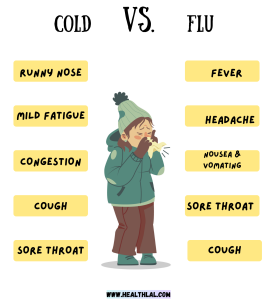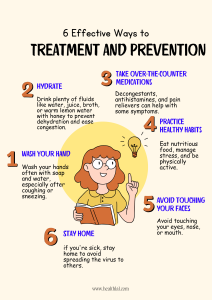 Cold vs Flu: Understanding the Differences for Better Health
Cold vs Flu: Understanding the Differences for Better Health
When you’re feeling under the weather, it can be tough to know whether you have a cold or the flu. Both illnesses manifest similar symptoms, but understanding the distinctions can greatly enhance your ability to recover swiftly. The common cold is generally milder, while the flu can lead to more severe complications.
Knowing whether you’ve caught a cold or coming down with the flu can make all the difference in your treatment approach and the precautions you take. According to the Centers for Disease Control and Prevention (CDC), adults have an average of two to three colds each year, while the flu affects millions, with seasonal flu outbreaks resulting in thousands of deaths each year.
Causes of Cold and Flu
A. Understanding the Viruses
Different viruses cause colds and flu.
- Common Cold Viruses: The most common culprit is the rhinovirus, but other viruses like coronaviruses can also cause colds.
- Influenza Virus Types: There are three main types of influenza viruses: A, B, and C. Types A and B are responsible for the annual flu seasons. Viruses work by invading your body’s cells and using them to replicate, which is what causes illness.
B. Transmission Methods
These viruses spread easily in several ways:
- Airborne Particles: When someone sneezes or coughs, tiny droplets containing the virus are released into the air.
- Surface Contact: Viruses can survive on surfaces for some time. Touching contaminated surfaces and then touching your face can lead to infection.
- Other Environmental Factors: Being in crowded places, especially during flu season, increases the likelihood of exposure.
C. Risk Factors for Infection
Certain factors can increase your risk of getting sick.
- Weak Immune System: Those with compromised immune systems, such as chronic illnesses, may be more vulnerable.
- Age Groups Most Affected: Children and older adults typically have higher incidence rates of both colds and flu.
- Lifestyle Factors: Habits like smoking and high-stress levels can negatively impact your immune response.
Symptoms Comparison
A. Initial Symptoms
Both conditions can start similarly, making it challenging to differentiate between them:
- Coughing and Sneezing: Both a cold and the flu can cause a cough and sneezing, but the flu often leads to a more intense cough.
- Runny or Stuffy Nose: A runny or congested nose is common in colds but can occur with the flu as well.
- Fever Presence: Fever is usually absent in colds and may be low-grade. The flu often presents with a high fever (over 100°F or 38°C).
B. Duration and Progression of Symptoms
Timing can also help you distinguish between the two illnesses:
- Common Cold Symptom Timeline: Symptoms typically take a day or two to appear and last about a week.
- Flu Symptom Timeline: Flu symptoms can onset suddenly and last longer—often one to two weeks, with peak severity within the first few days.
Complications such as bronchitis or pneumonia can arise from the flu, which are less common with a cold.
C. Severity of Symptoms
Understanding the intensity of symptoms is crucial:
- Mild Symptoms of a Cold: Generally, cold symptoms are annoying yet manageable. You may have a runny nose, mild fatigue, and a cough.
- Severe Symptoms of the Flu: The severity increases with the flu, often involving extreme fatigue, high fever, severe body aches, and chills.
- Recognizing Complications: It’s important to be aware of warning signs like difficulty breathing, chest pain, or a persistent high fever, which can signal complications like pneumonia.
 Treatment and Prevention
Treatment and Prevention
A. Home Remedies and OTC Medications
For both colds and flu, some strategies can help ease symptoms:
- Cold Relief Strategies: Over-the-counter medications like decongestants and antihistamines can reduce discomfort. Gentle rest, hydration, and remedies like honey and lemon can also help soothe coughs.
- Flu Relief Strategies: Antiviral medications (if caught early) and symptoms can be managed similarly, but rest is particularly crucial.
- Role of Hydration and Nutrition: Staying hydrated and eating nutrition-rich foods supports your immune system.
B. Prescription Medications
Sometimes, prescription drugs are necessary:
- Antivirals for Flu: Medications like oseltamivir (Tamiflu) can shorten the duration of flu symptoms if taken early.
- Antibiotics for Secondary Infections: While antibiotics don’t work on the flu or colds, they may be required if a bacterial infection develops as a complication.
- Assessing the Need for Medication: Always discuss options with your doctor to find the best course of treatment.
C. Prevention Strategies
Prevention is the best approach:
- Vaccination for Flu: The flu vaccine is your best defense against influenza, recommended annually.
- Good Hygiene Practices: Regular hand washing and using hand sanitizers can minimize the risk of infection.
- Lifestyle Adjustments for Immune Support: Eating a balanced diet, staying active, and managing stress also boost your immune health.
FAQs
A. Can you have both a cold and the flu simultaneously?
Yes, it is possible to have both, especially if your immune system is compromised.
B. How long can cold and flu viruses survive on surfaces?
Both can last from a few hours up to several days on various surfaces, depending on the material.
C. Are colds and the flu contagious? How do I protect myself?
Yes, they are contagious. Practice good hygiene, avoid close contact with sick individuals, and get vaccinated for flu prevention.
Your One-Stop Solution for All Healthcare Needs
Looking for a convenient and reliable way to access healthcare services? HealthLal has got you covered!
- All Healthcare Services in One Place: Explore comprehensive healthcare solutions tailored to your needs. Learn More
- Pathology and Radiology Tests: Book lab tests and radiology services with ease and accuracy. Book Now
- Consult with Doctors and Experts: Connect with experienced medical professionals for expert advice. Consult Now
Experience healthcare that is Accessible, Affordable, and Available at your fingertips with https://healthlal.com/ (Healthlal Techno Private Limited)!

